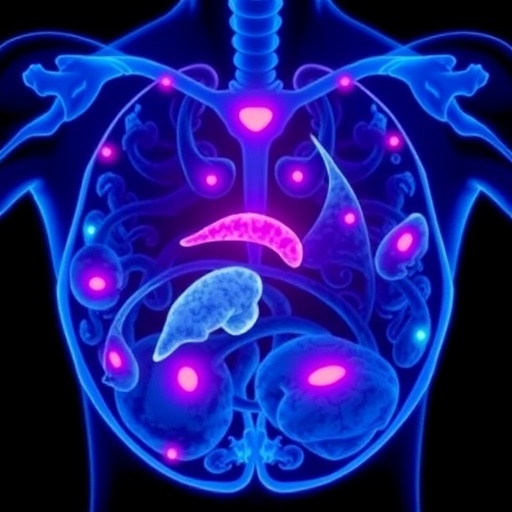In a remarkable leap forward for cancer therapeutics, researchers at UCLA, in collaboration with an international scientific team, have unveiled a pioneering treatment modality capable of detecting, eradicating, and reprogramming notoriously resistant tumors such as osteosarcomas and glioblastomas. This novel strategy harnesses a radiotheranostic antibody, termed DUNP19, engineered to specifically target the protein LRRC15. Expressed predominantly on aggressive cancer cells and their supportive stromal microenvironment, LRRC15 presents an ideal molecular beacon for dual-purpose diagnostic imaging and targeted radionuclide therapy.
DUNP19’s design capitalizes on the unique expression pattern of LRRC15, a leucine-rich repeat-containing protein upregulated in tumors but absent in healthy tissue, thus ensuring specificity and minimizing collateral damage during treatment. By conjugating DUNP19 to radioactive isotopes, notably Lutetium-177, this “guided missile” antibody navigates directly to the tumor and its microenvironment. It facilitates precise imaging to accurately stage and monitor disease progression while simultaneously delivering cytotoxic radiation specifically to tumor cells and their stromal defense, circumventing the traditionally indiscriminate collateral damage caused by conventional chemotherapy and external beam radiation therapies.
Preclinical investigations in murine models demonstrate that DUNP19-mediated radionuclide therapy significantly curtails tumor proliferation and enhances overall survival. Particularly notable were outcomes in osteosarcoma models, where treatment led to near-complete remission in bone-implanted tumors, a stark contrast to untreated controls. Similar therapeutic efficacy was observed in glioblastoma models, which notoriously resist current treatment regimens due to their heterogenous and immunosuppressive microenvironment. Moreover, models of triple-negative breast cancer and colorectal carcinoma further validated the broad utility of this approach across various LRRC15-expressing malignancies.
The mechanistic underpinning of this therapeutic success is multifaceted. LRRC15 expression, induced by the transforming growth factor-beta (TGFβ) pathway, defines a fibrotic and immune-excluding tumor stroma that acts as a physical and biochemical shield against immunotherapeutic agents. By selectively ablating LRRC15-positive stromal cells, DUNP19 disrupts this hostile microenvironment, permitting infiltration of immune effector cells such as CD8-positive cytotoxic T lymphocytes and natural killer cells. Concurrent gene expression analyses revealed a downregulation of immunosuppressive pathways coupled with an upregulation of T-cell activation markers, indicating a reprogramming of the tumor milieu from immune-resistant to immune-permissive.
The treatment’s theranostic versatility is accentuated by its ability to function dually in diagnostics and therapy. The antibody can be radiolabeled with isotopes emitting gamma radiation for high-resolution tumor imaging or beta radiation for targeted cytotoxicity, enabling clinicians to tailor strategies based on the clinical context. This integrative approach culminates in a personalized regime with improved precision, reduced adverse effects, and enhanced therapeutic response, overcoming limitations inherent in broad-spectrum modalities.
Importantly, the synergy of DUNP19-mediated radionuclide therapy with immunotherapies has forged an avenue for improving treatment outcomes. A singular low-dose intervention with DUNP19-radiotherapy markedly augmented the efficacy of checkpoint inhibitors in preclinical models, yielding durable anti-tumor immune memory. This breakthrough suggests a future combination paradigm wherein tumor debulking and microenvironment normalization by targeted radiation potentiate immune-based therapies.
The implications of this research reach far beyond the immediate cancer types studied. Since LRRC15 is predominantly overexpressed in aggressive tumors with dense fibrotic stroma, this approach could revolutionize treatment for a spectrum of refractory malignancies characterized by an immunosuppressive and treatment-resistant microenvironment. By enabling selective tumor eradication and microenvironmental reconditioning, DUNP19 represents a paradigm shift toward precision oncology where molecularly targeted radiotheranostics may become standard adjuncts to existing regimens.
These compelling preclinical findings have set the stage for imminent clinical translation. Led by Dr. Noah Federman, UCLA is orchestrating a first-in-human clinical trial slated to commence later this year, aiming to evaluate safety, imaging efficacy, and therapeutic potential of LRRC15-targeted radiotheranostic therapy in patients with metastatic osteosarcoma. Success in human trials could catalyze rapid expansion to other hard-to-treat malignancies, offering hope where therapeutic options remain scarce.
Overall, the UCLA team’s discovery underscores the power of integrating molecular targeting, radiopharmaceutical innovation, and immunological insight. Their groundbreaking use of DUNP19 not only disrupts tumor growth through precise radiation delivery but also reprograms the cancer stroma to permit potent, sustained immune-mediated tumor clearance. This dual modality exemplifies next-generation cancer therapy, with the potential to transform prognoses for some of the most recalcitrant tumors known to medicine.
Scientific and clinical communities eagerly anticipate further developments as this radiotheranostic platform progresses from bench to bedside, promising a novel weapon in the arsenal against aggressive, treatment-resistant cancers.
Subject of Research: Targeted radiotheranostic therapy for aggressive, treatment-resistant tumors using LRRC15-specific antibody DUNP19.
Article Title: Radiotheranostic antibody DUNP19 targets LRRC15 to detect, kill, and reprogram treatment-resistant tumors.
News Publication Date: 2025
Web References:
https://www.nature.com/articles/s41392-025-02410-9
References:
UCLA study published in Signal Transduction and Targeted Therapy, DOI: 10.1038/s41392-025-02410-9
Keywords: Osteosarcoma, Glioblastoma, LRRC15, Radiotheranostics, Targeted radionuclide therapy, Tumor microenvironment, Immunotherapy enhancement, Lutetium-177, Cancer stromal targeting, Tumor imaging, Radiopharmaceuticals, Precision oncology
Tags: aggressive tumor treatment strategiescancer diagnostic imaging techniquesDUNP19 antibody developmentglioblastoma therapy innovationsLRRC15 protein targetingLutetium-177 radiotherapyminimizing collateral damage in cancer treatmentosteosarcoma treatment advancementspreclinical cancer research findingsradiotheranostic cancer treatmenttargeted radionuclide therapytumor microenvironment targeting





